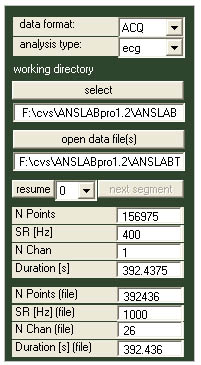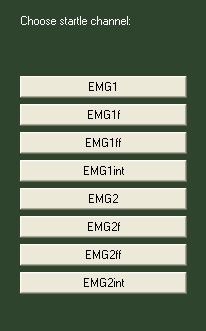the SETTINGS section

The
settings-section lets you
choose the data format you are using, the kind of analysis you wish to
perform, and the folders and files you are working with. It contains
fields that will be filled with general information about the data
you're analysing: sampling rate, duration, number of data points and
number of channels.
the 'data format'-popupmenu
Choose the file type, you are using. anslab at the present stage can
read BIOPAC acqknowledge and Vivologic data files. Support for plain
text files will be available soon.
the 'analysis type'-popupmenu
Here you select which
kind of processing steps you wish to perform on your data. Your
choice here also determines which channels will be read from a data
file for analysis. For BIOPAC acqknowledge files, anslab has a set of
possible channel labels to identify a specific channel. These are
listed in a file called 'channelnames.m' in the
'\anslabutil\ChannelNaming'-folder. If anslab does not find a
channel labelled as one of the items listed in this file for the
datatype in question (e.g. an 'ecg'-type channel, anslab will look for
the labels 'ECG Lead II', 'EKG' , 'EC' and 'ECG Lead I ')
, no data can be loaded. If there are several possible channels,
you will be prompted to choose the correct one from a list in the
dialog-section of the command window. For instance, for a startle
analysis, you might be given the choice to choose between multiple
EMG-channels found in a file, as shown below:

the 'working directory'-controls
Before running an
analysis, make sure to select your study folder with the
'select'-button in the navigation section. This allows anslab to store
the analysis results in the right places, without prompting you for
their location every time. Moreover, certain analysis require output
from prior analysis steps (e.g. analyzing electrodermal activity for
nonspecific fluctuations requires having analyzed accelerometer
information of that file beforehand), that are taken from the
corresponding subfolder in your study-folder.


